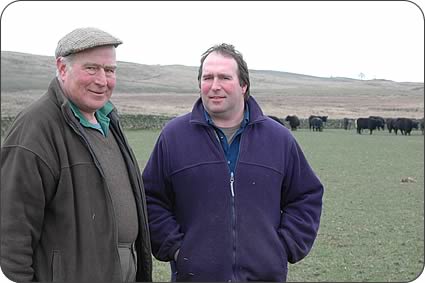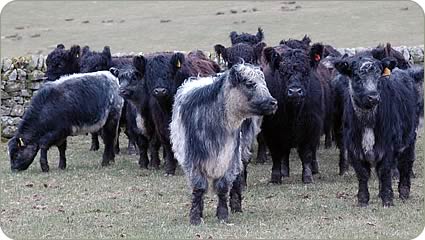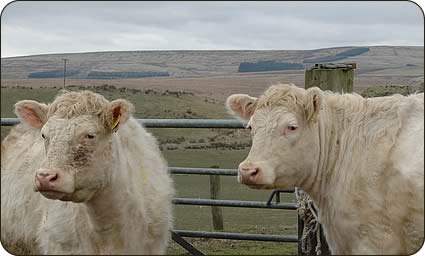Jennifer MacKenzie is an agricultural photo journalist with almost 30 year's experience. Operating from her base in Cumbria, Jennifer undertakes mainly industry-related freelance writing and photography.
Whitebred and Blue-Grey on the comeback trail
The Whitebred Shorthorn has played an integral part of the farming system on an upland Dumfriesshire unit for more than half a century.
It was demand for the Blue Grey, the hardy cross from the Whitebred Shorthorn bull and the Galloway cow, that led the Bell family to establish their own pedigree Shorthorn herd in the 1950s.
 |
| George and Ian Bell |
And now George Bell, his son Ian and wife Fiona remain loyal to the system which perfectly suits their 2,000-acre hill farm, The Bloch, near Langholm.
Attempts have been made to find another ideal hill cow, but no-one has been able to oust the Blue Grey,” said George.
The Blue Grey progeny are sold once a year with females selling as suckler cows to all corners of the UK and bullocks in demand by finishers supplying specialist butchers who favour traditional breeds.
“We first started breeding the Whitebred Shorthorn in the 1950s. We moved to The Bloch in 1941 and at the time we were breeding pure Galloways as the family had done for a long time,” said George Bell.
“At the time the Blue Grey was becoming more popular and our hill farm leant itself to that type of animal.
“There used to be a lot more breeders of Blue Greys with big sales at Haltwhistle and Newcastleton. After a decline in interest, the breed seems to have weathered the storm and breeders are coming back to the Whitebred and breeding the Blue Grey.
“Some people went out of Blue Greys but have now come back into them because the other breeds they were using did not last,” said George Bell.
 |
| Galloway cows with Blue Grey calves |
“The Blue Grey is very long-lived and you may get an extra five years, and an extra five calves, compared with other breeds. Beef producers farming in harsh conditions might think they would get a better return from the bigger, modern cows, but at the end of the day the Blue Grey lives longer and is much easier to feed.
“We’ve sold Whitebred bulls to farmers as far afield as Dartmoor, Derbyshire and Skye and as well as using them on Galloways, quite a few are crossing them very successfully with Highland cattle.”
An increasing number of Whitebred bulls are sold privately off the farm, however, recent leading prices for the herd at Carlisle sales are 3,000gns and 2,500gns
At the Bloch, which has heavy, wet land, the herd of 100 Galloway cows along with 10 purebred Whitebreds graze at up to 1,000ft on unimproved hill land which has rushes and heather. They would be capable of grazing on land at twice that height.
It is their ability to thrive in these conditions, with little or no concentrate feed, which is making the hardy Whitebred and its crossbred progeny increasingly popular again as low maintenance suckler cows.
Earlier born Blue Grey heifers are sold at the annual Newcastleton sale at the end of October at six to seven months old while others are kept on until the following year selling at 16 to 18 months old.
Blue Grey bullocks sold at 18 to 20 months old store through Longtown and Newcastleton are also in demand from finishers supplying beef to specialist local butchers.
 |
| Whitebred Shorthorn females |
“The Whitebred and the Blue Grey went through a bad patch for popularity but now people who have tried other breeds are coming back to the Newcastleton sale,” said George Bell.
“They have compared the economics. As well as the hardiness of these cattle, they live a lot longer and are easier kept and are very fertile. The quality of the meat from the Blue-Grey bullock is what more of these specialist butchers are looking for,” he added.
The Bells discovered the eating qualities of the pure Whitebred Shorthorn when they recently sold two non-breeding heifers which were approaching 30 months old to Waterbeck on-farm butcher David McGregor. “It was the most beautiful meat I have tasted,” said Mr Bell.
Galloway in-calf replacements are bought in mainly from Cumbrian breeder Gordon Kyle, of Spoutbank, Brampton.
Cows begin calving in April after having been housed since Christmas to save the ground, although the smaller cows cause less poaching than other breeds.
During housing they receive half a kg of cake a day as well as silage and straw. The cows are injected with Rotavec to prevent scour with calf deaths minimal as well as inoculated against fluke.
The cows calve easily with few assisted births and the calves are quick to get on their feet and suckle.
The females do not suffer from mastitis nor do they have problems with ticks.
“Traditional and native breeds are enjoying a come-back both from a producer and consumer point of view,” said Ian Bell.
“With the new Single Farm Payment, producers are wanting a low maintenance animal and once the Over Thirty Month rule is lifted it will enable those finishing cattle on extensive grass fed systems to sell them a little bit more mature,” he added.
The Bells also run a flock of 1,200 ewes along with hoggs and 240 replacements, 1,000 being pure South Country Cheviots with 200 Cheviot mules, which earned the family the Wool Producer of the Year title in 1998.
Cheviot rams and females are sold across the UK, with a number going into Wales – rams are sold at Lockerbie and Builth Wells – to a top price of £6,200. Last year’s Lockerbie champion sold for £6,000.

